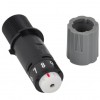The Silhouette software is great for making uniquely shaped cards. I make lots and I thought I'd share how to do it with you along with some tips and tricks.
If you base your card shape on an existing design all you really need to know is how to use the Offset and Weld Tools.
I've made almost every fish card in the Silhouette store for a family member who is into fish BIG time, and so I selected just a design, the Happy Fish design by Jennifer Wambach, to make my latest birthday card. This technique can be used to make cards of almost any shape however.
WHAT YOU'LL NEED:
Various colours of cardstock and paper
Heavyweight cardstock (300gsm plus)
Silhouette CAMEO®, Silhouette Portrait® or Silhouette Curio™
Happy Fish file by Jennifer Wambach (#62755)
Happy Birthday phrase by Samantha Walker (#10889)
STEP 1: The topper
The original file comprises 3 parts: the whole fish, the body and the scales. I cut the larger parts from cardstock and the scales from silver glitter paper.
STEP 2: The offset
The topper is finished by mounting it on a slightly larger shaped piece of cardstock - the 'offset'. This piece is required to hide the fact that the card base won't be as wide as the topper. It is made by using the Offset Tool.
Take a copy of the whole fish piece (green/teal), and paste it directly on top. To do this, select the piece, then Edit > Copy, then Edit > Paste in Front. It doesn't look as if anything has happened, but trust me, there are now two copies there. One copy will automatically be selected, keep it selected and open the Offset Window, click Offset and change the distance to your liking (I used 0.085", round). Click Apply. The new offset is larger than the original piece and colourless.
Move the original piece away and cut the offset. I'd recommend using at least a medium weight cardstock. This piece will be taking the weight of the card on it's narrow lower fins. If your chosen shape would be unstable (say, it is rounded at the bottom) it might be necessary to weld a rectangular base (as shown in the diagram above). If this is the case, I'd recommend that you make the card base first and come back to make an offset later.
STEP 2: The Card Base
The card base is made from a copy of the original whole fish piece (green/teal). It is made by welding two copies together at a point where they make a good size hinge. It can be at the left hand side, or at the top, depending on which suits your design shape better. Oftentimes a left-hand hinge makes a more stable card, as top folds have a tendency to open up and the card edges to slide apart.This is how I would go about it:
- Make a copy of the original whole fish piece. Select, Edit > Duplicate. Move one copy away.
- Make a mirrored copy of the piece in the Replicate window. Select, click on Replicate Window to open. Select 'Mirror Left'.
- Move the new copy to the right to overlap the original a good bit (your preference, but with a large enough overlap to form a stable hinge).
- Check they are level with each other. Select both, click Align Window icon, select Align Bottom.
- Join them together. Ensure both are still selected, click Modify Window icon, select Weld.
- (optional) Make the fold line (some folks prefer to score a line manually). Draw a vertical line holding down the shift key (this makes it a true vertical). Change it to your preferred line style and centre it. Open the Line Style Window, click on a line style. Then centre the line, select the welded shape and line, click Align Window, select Align Centre.
- Cut the card base from heavy-weight cardstock. I prefer something between 300 and 315 gsm to ensure that the finished card won't bend or buckle.
STEP 3: Assembling the Card
Once all the topper pieces are adhered together, simply stick the topper to the base. The topper will now be slightly larger than the base which will disguise any folding or alignement errors.
You can simply write directly on the card at this point. I cut out a Happy Birthday setiment from the glitter paper and stuck that to an offset of the card interior.
As I planned to send this card with a store gift card I also added a cutout to the offset to hold the card in place. I have the cardholder part saved in a file as I use it often. I'll save that for another tutorial, but this is what the finished interior piece looks like.
This technique can be applied to almost any flat design. I hope you'll try it out.
Bye for now,
DESIGNS USED:
 |
 |
PRODUCTS USED:
 |  |
 |
 |










Great idea thanks for the tut Janet
ReplyDeleteYou're welcome DJG - I use this technique for making uniquely shaped cards all the time.
DeleteSo inventive and yet so straightforward and great step by step instructions. Thank you Janet. x
ReplyDeleteThank YOU Jean. Please do share your makes if you use this technique.
Delete